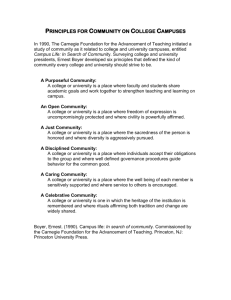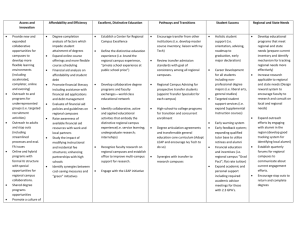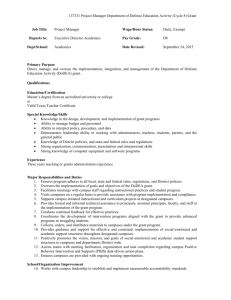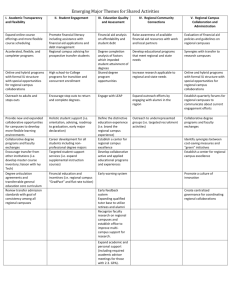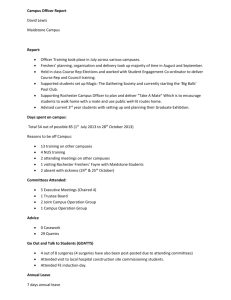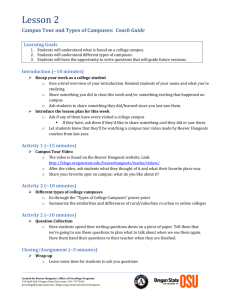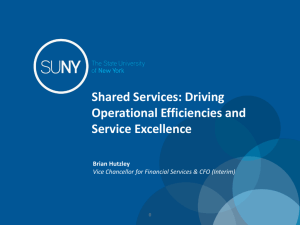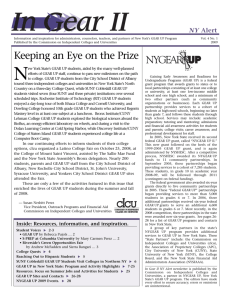Safeguards re the Utilization and Reporting of Assessment Results
advertisement
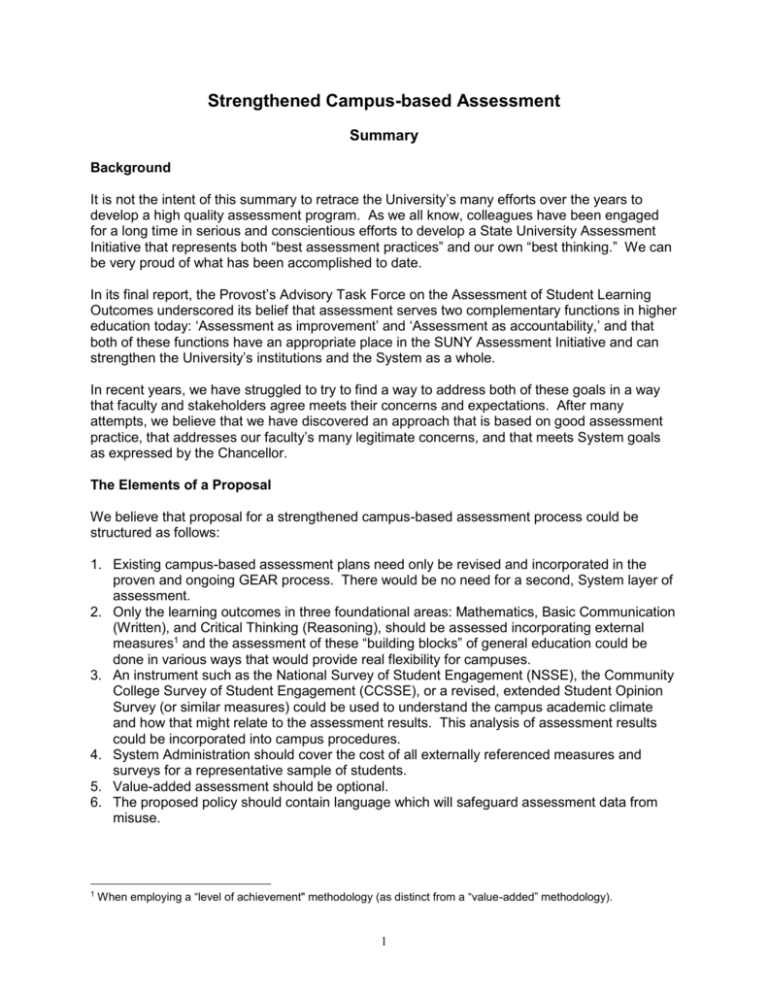
Strengthened Campus-based Assessment Summary Background It is not the intent of this summary to retrace the University’s many efforts over the years to develop a high quality assessment program. As we all know, colleagues have been engaged for a long time in serious and conscientious efforts to develop a State University Assessment Initiative that represents both “best assessment practices” and our own “best thinking.” We can be very proud of what has been accomplished to date. In its final report, the Provost’s Advisory Task Force on the Assessment of Student Learning Outcomes underscored its belief that assessment serves two complementary functions in higher education today: ‘Assessment as improvement’ and ‘Assessment as accountability,’ and that both of these functions have an appropriate place in the SUNY Assessment Initiative and can strengthen the University’s institutions and the System as a whole. In recent years, we have struggled to try to find a way to address both of these goals in a way that faculty and stakeholders agree meets their concerns and expectations. After many attempts, we believe that we have discovered an approach that is based on good assessment practice, that addresses our faculty’s many legitimate concerns, and that meets System goals as expressed by the Chancellor. The Elements of a Proposal We believe that proposal for a strengthened campus-based assessment process could be structured as follows: 1. Existing campus-based assessment plans need only be revised and incorporated in the proven and ongoing GEAR process. There would be no need for a second, System layer of assessment. 2. Only the learning outcomes in three foundational areas: Mathematics, Basic Communication (Written), and Critical Thinking (Reasoning), should be assessed incorporating external measures1 and the assessment of these “building blocks” of general education could be done in various ways that would provide real flexibility for campuses. 3. An instrument such as the National Survey of Student Engagement (NSSE), the Community College Survey of Student Engagement (CCSSE), or a revised, extended Student Opinion Survey (or similar measures) could be used to understand the campus academic climate and how that might relate to the assessment results. This analysis of assessment results could be incorporated into campus procedures. 4. System Administration should cover the cost of all externally referenced measures and surveys for a representative sample of students. 5. Value-added assessment should be optional. 6. The proposed policy should contain language which will safeguard assessment data from misuse. 1 When employing a “level of achievement" methodology (as distinct from a “value-added” methodology). 1 Proposed Revisions to the GEAR Guidelines To incorporate these elements into the GEAR process, very few changes are actually needed: Re “externally-referenced measures”, to GEAR Criterion #3, add the following: For the learning outcomes in Mathematics, Basic Communication (Written), and Critical Thinking (Reasoning), are externally referenced measures of the campus’s choice — either nationally- or SUNY-normed — included? For campuses opting to attempt to determine the growth in learning achieved by SUNY undergraduates in some or all of general education (“value-added”), is there an adequate description of when measures will be administered and how problems commonly related to pre- and post-testing (e.g., student motivation, attrition) will be controlled? Every effort has been made to describe “externally referenced measures” in a way that provides for meaningful external referencing while providing maximum flexibility for campuses. Not only will this address the longstanding concern of faculty that no proposal should promote a “one size fits all” approach, but it also renders any attempt to engage in inter-campus comparisons essentially meaningless. Campuses will continue to use their current approved assessment plans for all of the SUNY-GER learning outcomes. For the learning outcomes in the three “building blocks,” there are a number of ways in which campuses can meet the requirement for “externally-referenced” measures: for example, through the use of nationally-normed tests such as the Academic Profile, the California Critical Thinking Skills Test or the Quant-Q, or by using SUNY-normed measures in lieu of nationally-normed measures, using one of two approaches: i. A locally developed instrument that measures the learning outcomes in one or more of these three areas and that is demonstrated to correlate statistically (i.e., have concurrent validity) with nationally-normed measures. ii. A locally developed instrument that measures the learning outcomes in one or more of these three areas that is reviewed and approved by GEAR. As part of this process, GEAR will rely on discipline-based panels of distinguished SUNY faculty that will develop standards and rubrics campuses may use to assess student performance. Campuses choosing to use their own standards and rubrics must demonstrate to GEAR that their standards and rubrics are essentially equivalent to those developed by the discipline-based panel. Campuses opting for this approach would be expected to periodically provide GEAR with samples of student work for each standard of student performance, to be reviewed to ensure ongoing validity and reliability of the measure. Note that it is also possible to combine these approaches: for example, a campus might choose to use the CCTST for Critical Thinking and SUNY-normed measures for Mathematics and Basic Communication (Written). Re the “campus academic environment”, add a new GEAR Criterion (as #6) to: Ask that “Mechanisms for assessing the campus academic environment are described.” Re student involvement, to address the need for greater student involvement: Revise GEAR Criterion #7 — related to governance — to require that the plans show evidence of student involvement in the development of revisions to the assessment plan. 2 Safeguards re the Utilization and Reporting of Assessment Results To ensure that assessment results are used appropriately, it is essential that this process be guided by a set of principles that will safeguard assessment data, along the following lines: Assessment results will never be used to punish, publicly compare, or embarrass students, faculty, courses, programs, departments, or institutions either individually or collectively. Assessment results will never be used to make public comparisons among groups of students based on gender, race, ethnicity, or other demographic factors. A basic value of the State University is that all students can learn and the University’s programs are intended to provide educational opportunities to students as individuals, not by virtue of their membership within a particular demographic category. Given the vast diversity that exists among SUNY campuses — reflecting their unique missions and constituent groups — the public dissemination of assessment data for accountability purposes will take place only through aggregate reporting for SUNY as a whole and by sector (Doctoral Degree-granting Institutions, Comprehensive Colleges, Colleges of Technology and Community Colleges). Campus-specific assessment data will be used for confidential in-house discussions as part of the ongoing improvement process, whether between faculty and administrators on a particular campus or between campus representatives and System Administration officials. Faculty support for, and participation in this initiative is predicated on the responsible and collegial adherence to these principles. Costs The costs of the purchase and scoring of nationally-normed measures2 — as well as for the NSSE or CCSSE — should be paid for by System Administration for State-operated/funded institutions and community colleges, based on a sample size of up to 20% of the undergraduate student body on a three-year cycle. Next Steps System Administration has indicated that its goal is to move assessment forward through consensus and the Chancellor has said that if a faculty proposal met his expectations and has the support of governance, he would be willing to consider revisions to the June 17 Board resolution. 2 Currently estimated at under $200,000 for the entire system. 3

